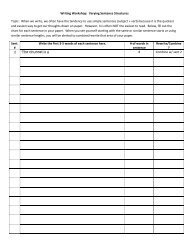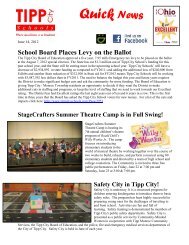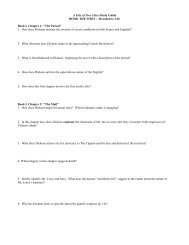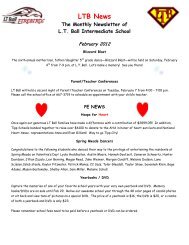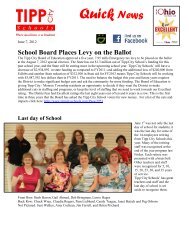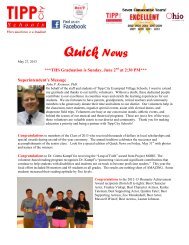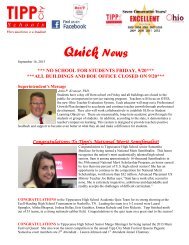Oral Presentation for the Junior Research Paper - Tipp City ...
Oral Presentation for the Junior Research Paper - Tipp City ...
Oral Presentation for the Junior Research Paper - Tipp City ...
Create successful ePaper yourself
Turn your PDF publications into a flip-book with our unique Google optimized e-Paper software.
<strong>Oral</strong> <strong>Presentation</strong> <strong>for</strong> <strong>the</strong> Sophomore <strong>Research</strong> <strong>Presentation</strong>Name___________________________Topic____________________________Only notes with 40 total words. You may spend those 40 words any way you want: onnotecards, on posterboard, or in power point. No more than 40 words (titles of topic onposter do not count)1 page outline with no additional in<strong>for</strong>mation, may add cues (“slow down” or “show visual aid”visual aid3-4 minutesDescribe your visual aid(s).When will you use it/<strong>the</strong>m during your speech?Why are you using this v.a.? What do you hope <strong>the</strong> audience will get out of it?Explain concerns you have about planning: topics, details, quotations, organization, transitions, visualaid(s), note cards, etc.What details about delivery will you concentrate on because you suspect <strong>the</strong>y are weaknesses <strong>for</strong>you? volume, rate, posture, eye-contact, hands, gestures
The IntroductionWhat will you say and/or do <strong>for</strong> your grabber? WFC 447 has some ideas. Describe your plan to grab <strong>the</strong> audience’sattention (will you tell a story, do a visualization, present a startling fact, etc?)Phrase how you will clearly focus on <strong>the</strong> topic of your presentation (this is your <strong>the</strong>sis)?Preview your three main points. This is adapted from of your <strong>the</strong>sis statement <strong>for</strong> public speaking purposes. It gives<strong>the</strong> audience a map of what <strong>the</strong>y can expect from you.1.2.3.Body of <strong>the</strong> SpeechThis will be <strong>the</strong> longest part of your speech.I. point onephrase your transition into point one; see WfC88-89 <strong>for</strong> suggestionsphrase <strong>the</strong> content focus of point one (topic sentence)list, outline, write <strong>the</strong> details you will present to develop <strong>the</strong> first point
II.point twophrase <strong>the</strong> transition you will use to introduce <strong>the</strong> second point; see WfC88-89 <strong>for</strong> suggestionsphrase <strong>the</strong> content focus of point two (topic sentence)list, outline, write <strong>the</strong> details that you will use to develop point twoIII.point threephrase <strong>the</strong> transition you will use to introduce point three; see WfC88-89 <strong>for</strong> suggestionsphrase <strong>the</strong> content focus of point two (topic sentence)list, outline, write <strong>the</strong> details you will use to develop point three
Review/summary and clincherPhrase <strong>the</strong> transition that will alert <strong>the</strong> audience that <strong>the</strong> end is coming; see WfC88-89Review your three main points; be sure to reemphasize an important detail from each point1.pointdetail2.3.phrase/describe your clincher (how will you effectively end <strong>the</strong> speech, perhaps an anecdote, quote, orfinal visualization)What are you most confident about going in to <strong>the</strong> speech?What are you most worried about going in to <strong>the</strong> speech?Remember: Practice times are normally LONGER than actual times.




